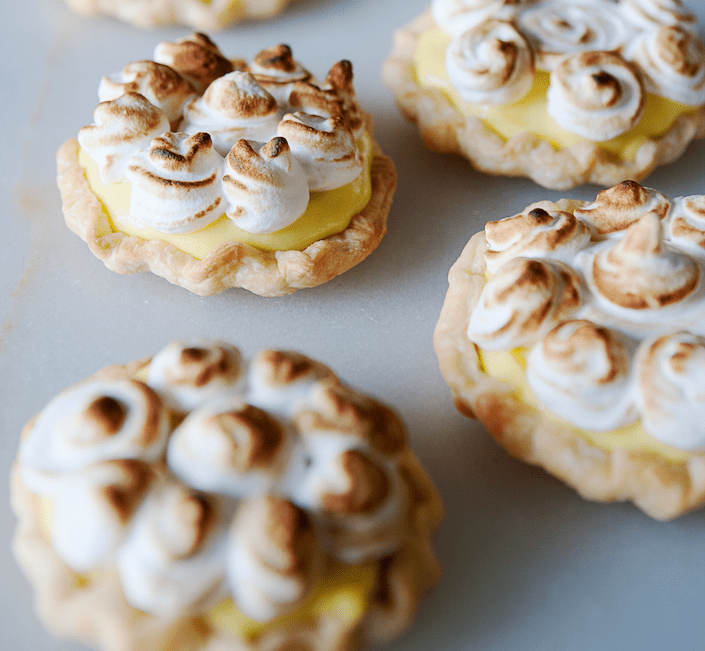LEMON MERINGUE TARTLETTES

MAKES 12
Lemon meringue pie is a classic. When I serve these personal LMPs, pretty as a picture sitting on the sideboard before lunch, I see guests’ eyes rove to the bright, cloud-like tops before the first course is served. Remarkably easy to put together, I’m so enamored of these tartlettes that I keep lemon curd in the freezer, along with ziptop bags of egg whites (they’ll keep for 6 months) left over from custard and ice cream making. Develop a reputation for lemon tartlettes at the drop of a hat.
INGREDIENTS
- 2 recipes Cream Cheese Pie Dough (recipe below) shaped into 3- by 4-inch rectangular blocks
- Egg wash (1 egg beaten with 1 tablespoon cool water and 1/4 teaspoon kosher salt)
- 3 egg whites (90 g), at room temperature
- 1/4 teaspoon cream of tartar
- 1/2 cup (100 g) granulated sugar
- 1/4 teaspoon vanilla extract
- 2-1/2 cups (680 g) Lemon Curd (recipe follows) or store-bought
DIRECTIONS
Heat the oven to 375˚F. Line two baking sheets with parchment. Roll one dough block out to an approximate 9- by 14- inch rectangle. Use a 4-1/2-inch cookie cutter (or a small plate) to cut out 6 rounds of dough. Move each round to the baking sheet and roll the edge inward, pinching and crimping to make a tart shell. Use a fork to prick holes (or “dock”) the centers and brush the edge with egg wash. Place the baking sheet in the freezer and repeat with the other dough block. Chill the 12 tart shells hard in the freezer for 30 minutes.
Drape a small piece of foil over each tart shell. Fill the foil with pie weights and blind bake the shells for 20 minutes. Remove the foil and weights and continue to bake an additional 10 minutes to dry out the crusts. Remove and cool on a rack.
In the bowl of a stand mixer with the whisk attachment, beat the egg whites on high until they are good and foamy. Add the cream of tartar and continue to beat on high. When the whites turn opaque, begin to add the sugar slowly, 1 tablespoon at a time, while the mixer continues to run. Once all the sugar has been incorporated, add the vanilla and beat until fully incorporated. Stop the mixer and lift the beater: You’re looking for a stiff peak, a very lofty meringue that stands up on its own. It will be glossy and smooth and sturdy. Be careful not to overbeat—the meringue should be shiny and moist, not dry.
Now you’re ready to put together the tartlettes. Place an oven rack about 6 inches from the top of the oven, close to the broiler element. Keep in mind the meringue will top the crust and be quite tall, as much as 2 inches above the baking sheet. In my oven, that means I place the rack in the top position. Turn the oven to broil.
Spoon 3 generous tablespoons of lemon curd into each crust, avoiding the edges. It should be thick and piled on. Add the meringue either by piping it or scooping up a big spoonful and plopping it across the surface, using the back of the spoon to make fluffy clouds. Here is a chance to decorate with a flourish, especially if you have a pastry bag and know how to use a St. Honoré tip.
Pop the tartlettes under the broiler for 3 or 4 minutes—not long at all. Do not take your eyes off the oven and open the door to peek frequently. Broil until you smell the unmistakable scent of toasting marshmallows. Let the edges and tips get very, very, slightly blackened like a campfire marshmallow. Now, they’re ready.
Serve within a few hours.
***
CREAM CHEESE PIE DOUGH
Makes 1 recipe pie dough
This tender, slightly tangy crust snuggles up to both sweet and savory fillings. It’s sturdy enough to cut into shapes, loves a good crimp, stands tall on the sides, and shines under an egg wash. Use full-fat cream cheese in a block, not whipped.
INGREDIENTS
- 1-⅓ cups (160 g) all-purpose flour
- 4 tablespoons (56 g) unsalted butter, cubed and frozen for 20 minutes
- 4 tablespoons (2 ounces, 56 g) cream cheese, cubed and refrigerated for 20 minutes
- 1/8 teaspoon kosher salt
- 1/4 cup (60 ml) ice water
DIRECTIONS
Place the work bowl of the food processor on the scale, set the scale to zero, and weigh the flour into the bowl. Weigh in the butter and cream cheese and add the salt. Move the bowl to the food processor base, insert the metal blade, cover, and use the Pulse function to cut the flour, butter, and cream cheese into flour-covered pea-sized pieces, about 15 quick pulses. Add the ice water all at once and process until the dough almost comes together in a ball. All the flour will be dampened and the dough will clump.
Spend time on this next step because the more compact and precise the dough, the easier it is to roll to the correct size and thickness. Form an X with two long pieces of overlapping plastic wrap and lightly flour the surface. Dump the dough onto the center of the plastic wrap, scraping the processor bowl clean. Wrap the sloppy gathering of dough in plastic and, at the same time, use a bench scraper (not your warm hands that might melt the fat clumps) to form the dough into a 4-inch disk or a 3-1/2- by 3-1/2-inch block. Once wrapped, use a rolling pin to gently press across the surface of the dough, then flip it over and do the same on the other side. Now let it rest: Refrigerate the dough for at least 4 hours or preferably overnight. Alternatively, slip the plastic- wrapped dough block into a ziptop bag and freeze it for up to 3 months. Defrost gently, overnight in the refrigerator.
WHEN PIES FLY guides the rolling pin novice and the experienced dough wrangler to dozens of shapes and styles of crusty, flaky, delicious treats. Barrow's well-tested, foolproof crust recipes means pie-making is fun, not scary, and her step-by-step techniques makes turning out a free-form pie practically foolproof.
WHEN PIES FLY includes many types of pastries (both homemade and store-bought), ready for the lunchbox, the dinner table, road trips, and picnics. These handy crusty offerings go from freezer to oven, and will win over everyone at the table. No one will be able to resist Sesame Chicken Hand Pies, Savory Nectarine Marscapone Tarts, Pork Pastor Empanadas, Spiced Apple Strudels, and much more. The perfect mix of nostalgic favorites and new pastry creations, WHEN PIES FLY is a wonderful dive into the world of pies in all of their forms.
By clicking ‘Sign Up,’ I acknowledge that I have read and agree to Hachette Book Group’s Privacy Policy and Terms of Use
